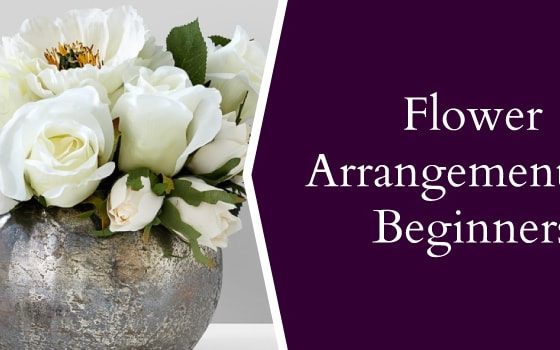Flower Arrangement for Beginners
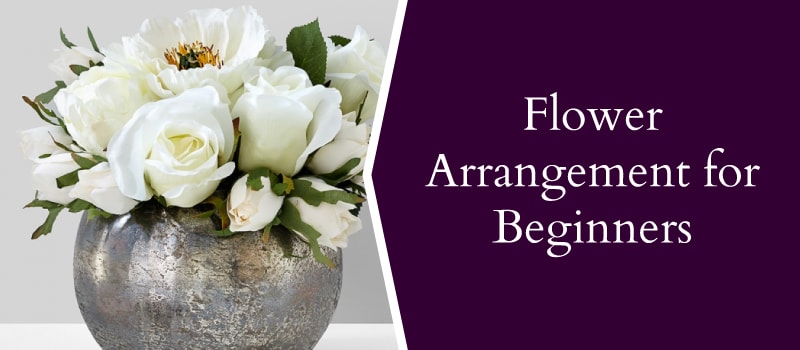
If you’re planning an elegant, bright, and exciting event like a wedding, your venue needs the class, personality, and vitality of beautiful blooms to match your aesthetic, complement your color scheme, and add natural charm to your decor. Whether you choose live flowers or lifelike silk flowers, a stunning arrangement can contribute to the overall success of your event with the elegance, wildness, subtlety, or unique properties of its blooms — but it has to be done right to match the professional finish of a florist without requiring the extra cost.

Did you know the average bride spends eight to 10 percent of her total wedding budget on floral arrangements? From corsages, boutonnieres, and bridesmaid bouquets to the reception flowers, ceremony arrangements, and bridal bouquet itself, purchasing professionally-arranged flowers can take up a significant portion of wedding costs. Instead of accepting the extra expense, take control of your event and take arranging, picking, and trimming into your own hands — whether you’re an event planner or a bride yourself!
Not sure where to start or how to arrange your artificial or live flowers for the best bouquets? We’re here to help! From where to get the best blooms, whether to choose live or silk, and how to pair a bouquet with the perfect vase to flower arranging techniques, tips on cutting silk flower stems, and tools needed for flower arranging, here’s everything you need to know about step-by-step flower arranging for beginners:
- Where to Buy Flowers For Your Arrangement
- Tools Needed for Flower Arranging
- Preparing Your Flowers
- How to Arrange Live Flowers
- How to Arrange Artificial Flowers
- Choosing a Container For Your Flower Arrangement
- Tips for Trimming Flowers
- Rules of Green Thumb
- What Flowers to Combine for Arrangements
- Selecting Stunning Silk Flowers at Jamali Garden
Where to Buy Flowers For Your Arrangement
Before you get started on putting those blooms together, you need to find the flowers themselves! First, figure out whether you’ll be using live flowers or silk flowers for your elegant arrangements. If you’re not sure which to choose, consider these differences to help you decide which is best:
- Live flowers require plant food and stem cutting to keep them fresh, perky and vibrant. Silk flowers, on the other hand, don’t need any maintenance — once you arrange them the way you desire, they’re good to go!
- Live flowers will eventually wilt and lose petals, while silk flowers hold their shape over time, remain flawless, and still look surprisingly realistic. This makes them ideal for reuse, use throughout long events, or even permanent arrangements.
- The debris left behind from live flowers — including plant food remnants, fallen leaves, and wilted petals — can be unpleasant on event eating tables or around floors and can make the blooms more difficult to clean up when the event is over. In comparison, silk flowers are crisp, clean, and easy to install and remove from your decor settings.
- Live flowers will need to be replenished with water, so you’ll either need to keep your arrangements in vases with water or attach them to water bags within their vases. Silk flowers, on the other hand, allow you to experience a clean, dry decoration process. Simply set them in your vases or wraps of choice without any extra care to keep them attractive.
- Live flowers will look vibrant, lush, and colorful while also smelling fragrant, but silk flowers appear almost as lifelike as the real thing and make stunning, soft arrangements.
When you’ve decided which type of flower fits more smoothly into your aesthetic vision, it’s time to purchase the blooms for your beautiful arrangements. If you’re looking for live flowers, search for local wholesale options and fresh flower markets. Most cities have floral districts offering a beautiful, natural selection of fresh-cut flowers in all varieties, colors, sizes, and quantities of annuals and perennials. If you don’t live near a flower market, try searching for reasonably-priced wholesale options at discount superstores or craft stores.
If you’re opting for beautiful silk flowers instead, you have just as many – if not more – colorful, vibrant, delicate, and elegant options and varieties to choose from. Your best sources for silk flowers are event decor stores and markets like Jamali Garden, which offers stunning, lifelike silk flowers and greenery in a wide variety of colors and types for any aesthetic. Find the flowers that match your event’s theme colors and evoke its mood in the best way.
Tools Needed for Flower Arranging
With your flowers picked, it’s time to prepare everything you need for your flower arranging techniques. Before you attend to the flowers themselves, you’ll need to make sure you have a few specific tools and materials for cutting, trimming, preparing, and keeping your flowers in place. Here’s what to have handy:
- Vases, jars, containers, or wraps to hold your finished flower arrangement
- Floral foam, styrofoam, or clay to serve as a base for your flower arrangement and hold the stems in place
- Dried moss or artificial moss to cover the foam base for a more natural look (optional)
- Floral tape, cling clay, or paddle wire to flexibly secure your flowers in place for the perfect arrangement
- Cutting pliers, flower shears, or clippers for trimming the stems
- A knife to cut your foam base
- Rubber gloves (for handling live flowers)
- Flower preservatives or plant food (for live flowers only)
Preparing Your Flowers
Now that you have both your tools and flowers of choice, it’s time to prepare them for arrangement. Depending on whether you’re handling live flowers or silk flowers, the process will look a little different. But when you’re finished, your bloom bouquets should look beautiful and authentic no matter what!
How to Arrange Live Flowers
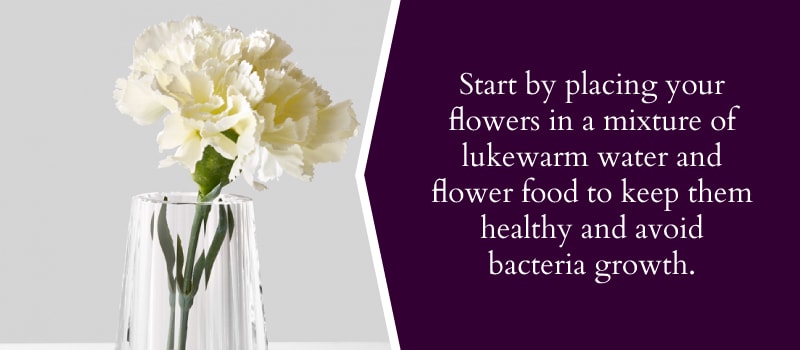
To arrange live flowers, you’ll need to begin with an extra prep step. Start by placing them in a mixture of lukewarm water and flower food to keep them healthy and avoid bacteria growth that might interfere with the fresh look of your finished arrangements. If a floral preservative doesn’t come with the fresh flowers you purchased, you can make your own by dissolving a tablespoon each of sugar and vinegar in a quart of water. Remove any wrapping and rubber bands that come on your blooms and trim the stems.
To cut your live flower stems in a healthy way, use your flower shears to trim about an inch off the bottom of each stem. Make a clean cut at about a 45-degree angle to help the flowers absorb the plant food better. Your flowers should remain in lukewarm water for a day or two before you begin to arrange them. When you’re getting them ready to arrange, make sure to wear rubber gloves and remove any thorns, leaves, and other jagged or unruly pieces from your flowers and stems. Trim another inch off your stems before you start.
Begin your arrangement with your floral foam base, making sure it’s the right size for the arrangement you envision. Think about whether your bouquet will be an oval, triangle, circle, or diamond shape when completed and consider whether you’d rather built the arrangement vertically or horizontally. Make sure your flowers and stems measure about one-and-a-half times the height of your chosen vase or container. Try to seat yourself at eye level with the flowers and at a good angle to observe the arrangement objectively as you build it.
Begin your flower arrangement with the largest blooms, placing the bigger flowers in the center and working outwards with the smaller flowers for a more balanced, proportional look. Stick the stems into the floral foam as you build your bouquet, making sure you vary the flower varieties and colors so you don’t have the same blooms concentrated in one spot. Step back from your arrangement every now and then to check for holes and focus on the overall appearance.
When you’re satisfied with your arrangement, secure the stems together with floral tape and place your arrangement in its vase or container. Feel free to adjust the flowers, stems, and foam a bit to make sure everything fits comfortably in the vase and presents a tasteful and finished arrangement.
How to Arrange Artificial Flowers
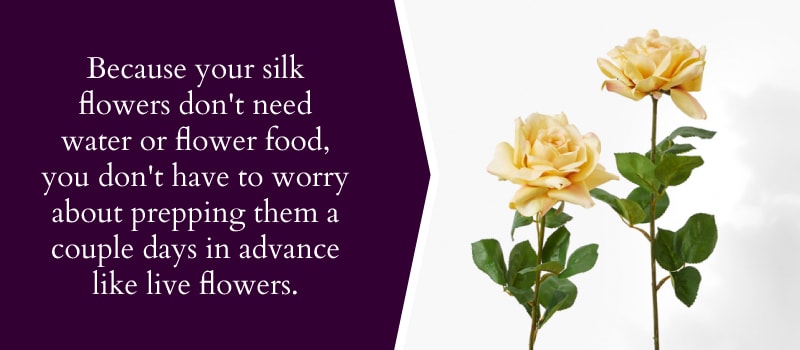
The process of arranging artificial flowers follows rather similar guidelines as live flower preparation — just with a few differences. Because your silk flowers don’t need water or flower food, you don’t have to worry about prepping them a couple days in advance like live flowers. When you have your flowers picked out and purchased, you can get started right away!
You will need to trim the stems, however, to avoid jagged ends, make sure your flowers are the right height for your arrangement, achieve a clean look, and ensure the ends stick in your foam base more easily. Because many silk flower stems have wire in their centers, use wire cutters to trim them at a 45-degree angle to your desired length.
Prepare your styrofoam or clay base first, covering it with moss if you desire a more natural look. If you’d rather use floral foam for silk flowers, it will work well too. To make the dried moss easier to attach, lightly spray it with water and shape it to your base, then place the base in the bottom of your vase or container. Before you begin adding your artificial blooms and building your bouquet, you’ll need to know how to shape silk flowers. Unlike live flowers, silk flowers won’t wilt or lose their volume, but you also need to shape them to your desired style to give them a lush, natural look.
Your silk blooms will like arrive compacted and squeezed together during shipment, so you may need to flesh out the petals and leaves before using them in your arrangement. Use your fingers to carefully spread apart the blossoms, leaves, and any branch pieces so they look natural and express volume. Then, gently use your thumb and two fingers to bend and shape the outer wired parts of petals and leaves to your desired appearance. You may also want to bend and curve the stems a bit to give the flower faces different directions for a more natural look.
When the flowers themselves are prepared to your satisfaction, begin to build out the bouquet in the same way you would with live flowers, using bigger blooms in the center and smaller flowers towards the edges, varying the types and colors of flowers throughout the arrangement. Secure your stems with floral tape or wire.
Choosing a Container For Your Flower Arrangement
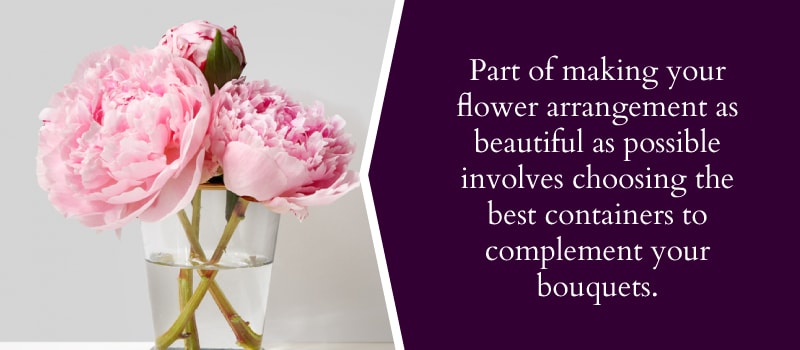
Part of making your flower arrangement as beautiful as possible and conveying the right degree of elegance, whimsy, and vitality to match your event involves choosing the best containers to complement your bouquets. Whether you’re looking for cylinder-shaped vases, bowls, more traditional vases, or other shapes in crystal, mercury glass, metal, wood, or ceramic finishes, you can find a wide selection of tasteful vases and containers for your flowers at Jamali Garden.
Pairing vases with flowers for the perfect fit depends on a wide variety of factors, including the size, shape, and style of your bouquet and the type of aesthetic you’re hoping to achieve. Tall, slender flower arrangements tend to look and fit best in cylinder or hourglass-shaped vases, while wide, stout bouquets might be better suited to bowls. In terms of the overall look, it’s important to match, offset, or complement both the flowers themselves and the other decor at your event. If you’re aiming for a rustic or vintage aesthetic, for example, wood and metal vases may look best in your venue, while crystal and ceramic containers may be better suited towards more elegant, refined, and sophisticated themes.
Since the potential combinations for pairing flowers and vases are nearly endless, we’ve put together a graphic to ensure you can’t go wrong:

Whatever style container you choose, be sure to cut your flowers to the right size to fit proportionally and aim to complement the shape of the vase with the shape of the bouquet.
Tips for Trimming Flowers
If you need a little help cutting silk flower stems to make your arrangement tasteful and clean, try these tips for measuring, cutting, and keeping your stems supported:
- Flower arrangements should measure about one-and-a-half to two times the height of your vase. Be sure to measure your stems and cut them accordingly before placing them in your vase.
- Cut your silk flower stems at a 45-degree angle to form a pointed edge that will stick better in your foam or clay base.
- If the wire in your silk stems makes them difficult to cut, use cutting pliers to grip the stem, then bend it back and forth to break it and trim the uneven edges.
- Allow a little extra length on your stems to anchor them in the foam or clay base. When you measure your stems and flowers, cut a couple inches down from the right measurement to make room for stem support when the flowers are standing in their container.
Live flower stems require trimming every day or two to allow for easier absorption of their water and nutrients. Again, cut these at a 45-degree angle. When your live leaves and petals begin to wilt or brown, carefully remove them with stem cutters or pick them off to keep the arrangement looking fresh.
Rules of (Green) Thumb
Even if you trust your eye for design when arranging your flowers for the most beautiful bouquet, there are a few essential tips and techniques you might not know as a beginner. For live and silk flower arranging 101, here are some rules you’ll want to follow to make your bouquets really pop:
- When building your bouquet and placing new flowers into your arrangement, it’s best to add in threes. This will balance out the colors and types of flowers in your arrangement by subconsciously leading you to address all sides, and rounding out your choices.
- When working with live flowers, remove any leaves that will fall below the waterline. They’ll only wilt and drag your bouquet down with a look that’s less than fresh.
- You might like a wild look, but unruly stems will complicate any arrangement and make your bouquet more difficult to fit into its vase. Make sure to clean up your stems, even if they’re made of silk. Keep the arrangement symmetrical-looking by cutting the outer flowers’ stems shorter.
- Again, position your larger blooms toward the center and your smaller flowers around the outsides of the arrangement to balance it out.
- When you have holes or extra spaces in your bouquet, you can fill them out by using real or artificial greenery. The extra foliage and leaves will also vary your colors and add a bit more visual interest to your arrangement.
What Flowers to Combine for Arrangements
When it comes to choosing the types of flowers for your arrangements, it’s all about your color scheme, style, and the mood you’re hoping to convey. Are you going for a rustic, natural vibe or an elegant, upscale theme? Are you featuring warm, summery hues, subdued neutrals, or cool colors?
You should also consider seasons when selecting the best blooms. Maybe you want your flowers to be in-sync seasonally — like magnolias in late spring and hydrangeas during the summer, or evoke a certain seasonal vibe, like autumn mums and pansies. Whatever look you hope to embody with your blooms, here are a few tried-and-true ideas for the most attractive flower arrangements:
- Monochromatic Palettes: Sometimes a simple color palette is the best pick for beautiful flower arrangements. Whether you’re catering to a color scheme of whites and creams, bright orange and yellow, soft pinks, or subtle violets, sometimes sticking to one color family can make your bouquet look impossibly elegant. Choose flowers in varying shades of the same color or similar colors — like lilacs, lavender, and violets or pink peonies, carnations, and roses — to create a tasteful, unique ombre flower arrangement.
- One-of-a-Kind Blooms: Some flowers have such perfect aesthetics and singular personalities that they don’t need other varieties to complement them. Whether you’re channeling bold vibes or an elegant aesthetic, the beauty of one bloom can form a bouquet that’s simple while still far from uninteresting — think sunflowers, roses, peonies, and ranunculi.
- Whimsical Mixes: While some flowers, like always-tasteful magnolias and hydrangeas, seem to fit together classically, sometimes the best combinations are the most unusual. If you’re not afraid to incorporate a quirky or whimsical vibe into your flower arrangement, opt for surprising mixes in season, color, shape, symmetry, and type of flower. Add in exotic elements like orchids, succulents, and wildflowers and pair them with more subdued blooms like lavender, peonies, or Queen Anne’s lace for an arrangement that catches every eye.
Select Stunning Silk Flowers at Jamali Garden
If you’re looking for the most beautiful selection and the widest variety of blooms for your silk flower arrangement ideas, Jamali Garden is the perfect place to find everything you need. With long-lasting, lifelike silk flowers and greenery in so many options, we’re sure to make your arrangement stand out exquisitely at your wedding or event. Browse our selection and explore our wholesale options today.
Shop this post!

